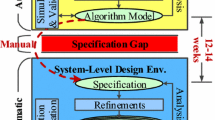Abstract
In this paper, we present a hardware-software cosimulation environment for heterogeneous systems. To be an efficient and convenient verification environment for the rapid prototyping of heterogeneous systems consisting of hardware and software components, the environment supports (i) modular cosimulation, (ii) cosimulation acceleration, and (iii) integrated user interface and internal representation. For modular cosimulation, we treat software and hardware components as separate processes that communicate with each other only through inter-process communication. We generate interface model automatically and insert between software and hardware components. We can accelerate cosimulation through hardware-emulation using FPGAs which also supports our incremental system prototyping strategy. Finally, to provide an integrated user interface and internal representation consistent with various prototyping tasks, we modified and extended Ptolemy, a cosimulation and cosynthesis environment for heterogeneous systems. The benefits of our cosimulation environment are as follows: expandability of the environment, target architecture and protocol independence, interface transparency, seamless transition to cosynthesis, cosimulation speedup, and convenient cosimulation. As experimental examples, we cosimulated and prototyped several heterogeneous systems successfully, which shows that our environment can be a useful heterogeneous systems specification/verification environment for fast prototyping.
Similar content being viewed by others
References
J.A. Rowson, “Hardware/software co-simulation,” in Proceedings of 31st ACM/IEEE Design Automation Conference, pp. 439–440, June 1994.
W. Ye, R. Ernst, Th. Benner, and J. Henkel, “Fast timing analysis for hardware-software co-synthesis,” in Proc. ICCD '93, October 1993.
R.K. Gupta, C. Coelho, and G. De Micheli, “Synthesis and simulation of digital systems containing interacting hardware and software components,” in Proceedings of 29th ACM/IEEE Design Automation Conference, pp. 129–134, June 1992.
D. Becker, R.K. Singh, and S.G. Tell, “An engineering environment for hardware/software co-simulation,” in Proceedings of 29th ACM/IEEE Design Automation Conference, pp. 129–134, June 1992.
D.E. Thomas, J.K. Adams, and H. Schmit, “A model and methodology for hardware-software codesign,” IEEE Design and Test of Computers, 10(3): 6–15, September 1993.
A.S. Wenban, J.W. O'Leary, and G.M. Brown, “Codesign of communication protocols,” IEEE Computer, 26(2): 46–52, December 1993.
K.A. Olukotun, R. Helaihel, J. Levitt, and R. Ramirez, “A software-hardware cosynthesis approach to digital system simulation,” IEEE Micro, 14(4): 48–58, August 1994.
T.B. Ismail and A.A. Jerraya, “Synthesis steps and design models for codesign,” IEEE Computer, 28(2): 44–52, February 1995.
A. Kalavade and E.A. Lee, “A hardware-software codesign methodology for DSP applications,” IEEE Design and Test of Computers, 10(3): 16–28, September 1993.
W.R. Stevens, UNIX Network Programming, Prentice-Hall, 1991.
Y.S. Lee and P.M. Maurer, “Two new techniques for compiled multi-delay logic simulation,” in Proceedings of 29th ACM/IEEE Design Automation Conference, pp. 420–423, June 1992.
D.H. Ko and K. Choi, “IVDT: A VHDL developer's toolkit,” KITE Journal of Electronics Engineering, 5(2): 56–63, December 1994.
The Institute of Electrical and Electronics Engineers, Inc., New York, IEEE Standard VHDL Language Reference Manual, ANSI/IEEE Std 1076-1993, 1994.
L64853A SBus DMA Controller Technical Manual, LSI Logic, 1991.
Y. Kim, Y. Shin, K. Kim, J. Won, and K. Choi, “Efficient prototyping system based on incremental design and module-by-module verification,” in Proceedings of IEEE ISCAS 95, pp. 924–927, May 1995.
K. Kim, Y. Kim, Y. Shin, and K. Choi, “An integrated hardware-software cosimulation environment with automated interface generation,” in Proc. 7th IEEE Int'l Workshop on Rapid System Prototyping, pp. 66–71, June 1996.
Y. Kim, K. Kim, Y. Shin, T. Ahn,W. Sung, K. Choi, and S. Ha, “An integrated hardware-software cosimulation environment for heterogeneous systems prototyping,” in Proc. of Asia and South Pacific Design Automation Conference, pp. 101–106, August 1995.
The Programmable Logic Data Book, Xilinx, 1993.
Standard for a Chip and Module Interconnect Bus: SBus (P1496/Draft 2.3), IEEE Standard Department, 1993.
User Guide for DAWN VME Products DPS-1: Development Platform SBus Version 1.0 Revision B, DAWN VME Products, April 1991.
J. Buck, S. Ha, E.A. Lee, and D.G. Messerschmitt, “Ptolemy: A framework for simulating and prototyping heterogeneous systems,” International Journal of Computer Simulation, 4: 155–182, April 1994.
J. Ziv and A. Lempel, “A universal algorithm for sequential data compression,” IEEE Transactions on Information Theory, IT-23(3): 337–343, 1977.
S. Narayan and D. Gajski, “Interfacing incompatible protocols using interface process generation,” in Proc. of 32nd ACM/IEEE Design Automation Conference, June 1995.
K. Kim, “Generation of interface module in hardware-software co-design,” M.S. Thesis, Dept. of Electronic Eng., Seoul Nat'l Univ., December 1995 (in Korean).
Y. Shin and K. Choi, “Thread-based software synthesis for embedded system design,” in Proc. of European Design and Test Conference, March 1996, to be published.
Y. Shin and K. Choi, “Software synthesis through task decomposition by dependency analysis,” in Proc. of Int'l Conf. on Computer Aided Design, pp. 98–102, November 1996.
Y. Kim, K. Kim, and K. Choi, “Efficient VLSI architecture for lossless data compression,” IEE Electronics Letters, 31(13): 1053–1054, June 1995.
Y. Kim, K. Kim, K. Choi, and I. Park, “A scalable VLSI architecture for Lempel-Ziv-based data compression,” in Proc. 5th Int'l Conf. on VLSI and CAD, pp. 355–357, October 1997.
T. Shanley and D. Anderson, ISA System Architecture, 3rd edition, MindShare, Inc., 1995.
ISO/IEC JTC1/SC29/WG11, Coding of Moving Pictures and Associated Audio, Recommendation H.262, (ISO/IECJTC1/SC29/WG11 N0702rev), March 1994.
S. Uramoto et al., “A 100-MHz 2-D discrete cosine transform core processor,” IEEE Journal of Solid-State Circuits, 27(4): 492–499, April 1992.
J. Chang, “Interface synthesis using bank switching,” M.S. Thesis, Dept. of Electronic Eng., Seoul Nat'l Univ., December 1997 (in Korean).
Author information
Authors and Affiliations
Rights and permissions
About this article
Cite this article
Kim, Y., Kim, K., Shin, Y. et al. An Integrated Cosimulation Environment for Heterogeneous Systems Prototyping. Design Automation for Embedded Systems 3, 163–186 (1998). https://doi.org/10.1023/A:1008842424479
Issue Date:
DOI: https://doi.org/10.1023/A:1008842424479




